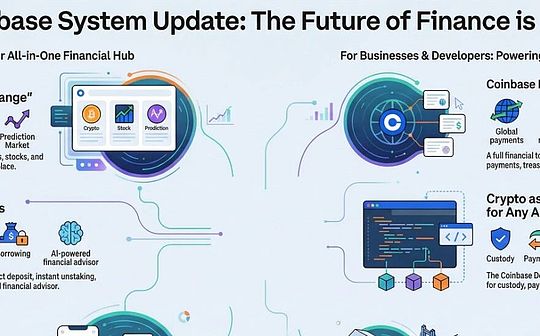
Author: avi zurlo Source: nil translation: Shan Ouba, Bitchain Vision Realm
Since the rise of Rollups, blockchain expansion has been concentrated in modularity and overall argument.Initially, this two -point method was a useful psychological model of the scalability of the inference blockchain, but both camps had surpassed it.
Today, the comparison between modularity and overall type has brought unnecessary restrictions to our scalability thinking model.
So, what other choices?
In this article, we show that horizontal and vertical extensions are always the basic framework for blockchain scalability, and explains how to use horizontal and vertical how to bring better expansion solutions.
Understand the modular and overall type
First, some definitions:
ModularThe core function of the blockchain is divided into different layers.
Single filmThe chain integrates all core functions into a interconnected layer.
We can regard the “layer” as the same as the “machine” -the overall chain has a verification device node running all tasks, and the modular chain has multiple (2-3) full nodes that run different tasks.

For example, Rollup usually has two operating nodes: the Rollup full node for executing and the Ethereum node for settlement + data usability (DA).Validium may use three operating nodes: Rollup full node for executing, Ethereum node for settlement, and alternative data availability layer for DA.
The modularization of the blockchain is divided into at least two full nodes.By doing this, the modular blockchain can use the computing power of multiple machines when constructing each block.
This is a horizontal scalingA form.
Modification is useful for considering the expansion of the blockchain because it is a horizontal scalability.

On the other hand, most single camps choose to expand through software optimization, implementing parallel virtual machines, data pipelines, faster network protocols, and (most noteworthy) to expand more powerful hardware.In essence, a single chain tries to squeeze as much computing power from a single full node.
This is vertical zoomA form.
Critics said that this method tends to centralize: If the ability to increase a single node is expanded, it will inevitably encounter physical restrictions on the underlying hardware, and it is forced to increase the hardware requirements to further expand.
However, this criticism is wrong, because not all the overall chains only depend on vertical expansion.
For example, Near is an overall L1 blockchain based on a shard network architecture.This means that the near -node is responsible for all tasks (that is, execution, settlement, and data usability), but they are only responsible for a small part of the global state.Therefore, NEAR uses the power of multiple machines (like a modular chain) based on the state rather than the task division.

We can see that the overall chain and the modular chain are unlimited in terms of expansion technology they realize.Both can be scaled horizontally and/or vertically.
In addition, modular and overall controversy has always been rooted in horizontal and vertical extension frameworks.From a strict technical perspective, the modularity is inclined to expand, which is inherent in its design, and the overall bias is vertical expansion.
Now we have successfully launched a modular chain, and the additional expansion advantages are no longer “more modular”.The focus is now how the chain uses level or vertical extension technology.
Using horizontal and vertical psychological models enables us to easily reasoning the balance of each chain in this process.
Reconstruction dialogue: level and vertical extension
Vertical expansion
Vertical extension will increase the hardware utilization or hardware requirements of each node.In the blockchain, this is usually completed by software optimization such as parallel virtual machines (that is, multi -thread process).
A popular example here is EVM and SVM.
EVM sequential execution of affairs, and SVM parallel execution affairs.SVM can achieve this by using more CPU cores, so SVM can handle more transactions than EVM per second.Note: This type of vertical zoom is the basis behind the Eclipse L2.
In terms of weighing, vertical extensions are limited by available hardware. Due to the increase in hardware demand, it tends to be centralized, and compared with horizontal expansion, it has poor scalability.

Horizontal expansion
On the other hand, the horizontal expansion increases the number of machines that the system can access by dispersing workloads to multiple nodes.As mentioned earlier, the modular chain is essentially assigned tasks to multiple machines.However, chains can often achieve a larger level of expansion through sharding.

= nil; here a useful example is provided.
In November last year, = nil; the foundation launched a name calledzkShardingIt can prove the fragments, which is the foundation of the new Ethereum L2 = nil;.= nil; The core of design is to divide its global state to multiple shards.Each shard is operated by a decentralized committee of = nil; it builds a block and manages the verifications of cross -shard transactions.In addition, each shard will generate an effective proof, which will be sent to the main film for aggregation, and then publish and verify on Ethereum.= None; through the two ways to use the power of horizontal expansion:
-
First of all, = nil; it is a modular blockchain that uses the strong consensus and data usability guarantee of Ethereum, thereby distributing tasks on multiple full nodes.
-
Second, = nil; it is a segment blockchain, so partially distributed on many complete nodes.
Both technologies have reduced the load that any single machine needs to bear and improves the overall scalability of the network.
So, what are the trade -offs of horizontal expansion?Between two points: the complexity of network and consensus, as well as asynchronous communication between machines or shards.
Ethereum scalability final game
Horizontal or vertical extensions are not limited to modular or overall architecture.This is why the horizontal and vertical extension framework provides more space to explore new solutions, making the modular blockchain more scalability.
For example, a choice is a layer of vertical zoom modular stack.A popular method is to achieve parallel virtual machines to expand the execution of throughput.As mentioned above, Eclipse is using SVM and other Rollup (such as StarkNet) to implement blockstm to achieve parallelization.
However, vertical extensions are always limited by single machines, and we cannot break the law of physical.
A solution may be to choose to expand horizontally through sharding.
The current modular design has just begun to touch the total potential of horizontal expansion.Through slice, we can use the ability of any number of machines (rather than divide 2-3 machines by task).
In other words, many machines can run the same type of tasks in parallel.This is the goal of Ethereum and Celestia hoping to achieve through Danksharding and data shards respectively.However, the sharding is not limited to the data usability layer -it can also be combined with execution (such as the situation of = nil; l2).

If we will combine horizontal extensions implemented by modular stacks with the horizontal expansion provided by shards, we will obtain a significant increase in available computing power.
The ultimate goal of the blockchain scalability will be merged and vertical expansion, thereby generating a segment blockchain with parallel virtual machines.







